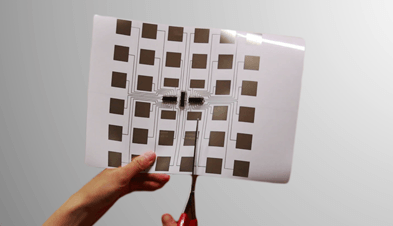Printed Electronics: Cutting The Wires Without Losing Functionality
October 18, 2013
on
on

New circuit topologies make it possible to customize the shape of printed electronic devices with scissors.
Researchers of the Max Planck Institute in collaboration with the MIT Media Lab present a novel method to alter the shape and size of printed electronic devices. As a proof of concept they developed a multi-touch sensor which maintains its functionality even after parts of the circuit are cut off.
Printed electronics techniques are maturing fast. With ordinary inkjet technology and special ink electronic circuits can be printed on thin flexible substrates resulting in cheap flexible devices. It is also possible to use roll-to-roll printing for mass production. These developments open the way for a wide range of new applications such as intelligent packaging, wearable electronics and bendable OLEDs.
With their customizable devices the German-American team aims to bring creative play with electronics to end users. They can enhance ordinary objects such as clothing or furniture with electronics. The researchers write in their paper: 'For ubiquitous computing, people can easily add multi-touch input on pretty much any physical object or surface, by using an adhesive multi-touch foil that is cut to match the desired size and shape. This enables people to easily touch-augment physical objects and devices. In prototyping and crafting, touch-enabled paper, cardboard or plywood empowers people to make models, prototypes and artwork interactive.'
To make the multi-touch sensor survive a treatment with scissors the team came up with new wiring topologies. Traditionally, the circuit for such a sensor is grid-structured. The wires run horizontally and vertically with an electrode on each intersection serving as a touch point. This setup requires the least amount of wires. However, when one wire is cut a series of electrodes become unusable. Also, the connectors which link the sensor to a controller are placed on the borders of the grid, preventing them from being removed.
By creating new wiring schemes the researchers address these limitations. In the star topology the connector is placed at the center of the device and wires extend radially to the electrodes. Each electrode is point-to-point linked to the connector, to avoid one damaged wire knocking out multiple touch points. The star topology allows for shapes like triangles, ellipses, stars and clouds.
The tree topology also has connector in the center which is wired to each electrode individually. Only here the wires run in straight lines branching of to meet the electrodes. The tree supports different shapes than the star such as carve-outs at the borders of the sheet.
These novel topologies not only allow for shape customization they also add robustness against damage. A single tear of the substrate won't cause the device to lose a substantial part of its functionality.
Researchers of the Max Planck Institute in collaboration with the MIT Media Lab present a novel method to alter the shape and size of printed electronic devices. As a proof of concept they developed a multi-touch sensor which maintains its functionality even after parts of the circuit are cut off.
Printed electronics techniques are maturing fast. With ordinary inkjet technology and special ink electronic circuits can be printed on thin flexible substrates resulting in cheap flexible devices. It is also possible to use roll-to-roll printing for mass production. These developments open the way for a wide range of new applications such as intelligent packaging, wearable electronics and bendable OLEDs.
With their customizable devices the German-American team aims to bring creative play with electronics to end users. They can enhance ordinary objects such as clothing or furniture with electronics. The researchers write in their paper: 'For ubiquitous computing, people can easily add multi-touch input on pretty much any physical object or surface, by using an adhesive multi-touch foil that is cut to match the desired size and shape. This enables people to easily touch-augment physical objects and devices. In prototyping and crafting, touch-enabled paper, cardboard or plywood empowers people to make models, prototypes and artwork interactive.'
To make the multi-touch sensor survive a treatment with scissors the team came up with new wiring topologies. Traditionally, the circuit for such a sensor is grid-structured. The wires run horizontally and vertically with an electrode on each intersection serving as a touch point. This setup requires the least amount of wires. However, when one wire is cut a series of electrodes become unusable. Also, the connectors which link the sensor to a controller are placed on the borders of the grid, preventing them from being removed.
By creating new wiring schemes the researchers address these limitations. In the star topology the connector is placed at the center of the device and wires extend radially to the electrodes. Each electrode is point-to-point linked to the connector, to avoid one damaged wire knocking out multiple touch points. The star topology allows for shapes like triangles, ellipses, stars and clouds.
The tree topology also has connector in the center which is wired to each electrode individually. Only here the wires run in straight lines branching of to meet the electrodes. The tree supports different shapes than the star such as carve-outs at the borders of the sheet.
These novel topologies not only allow for shape customization they also add robustness against damage. A single tear of the substrate won't cause the device to lose a substantial part of its functionality.
Read full article
Hide full article


Discussion (0 comments)